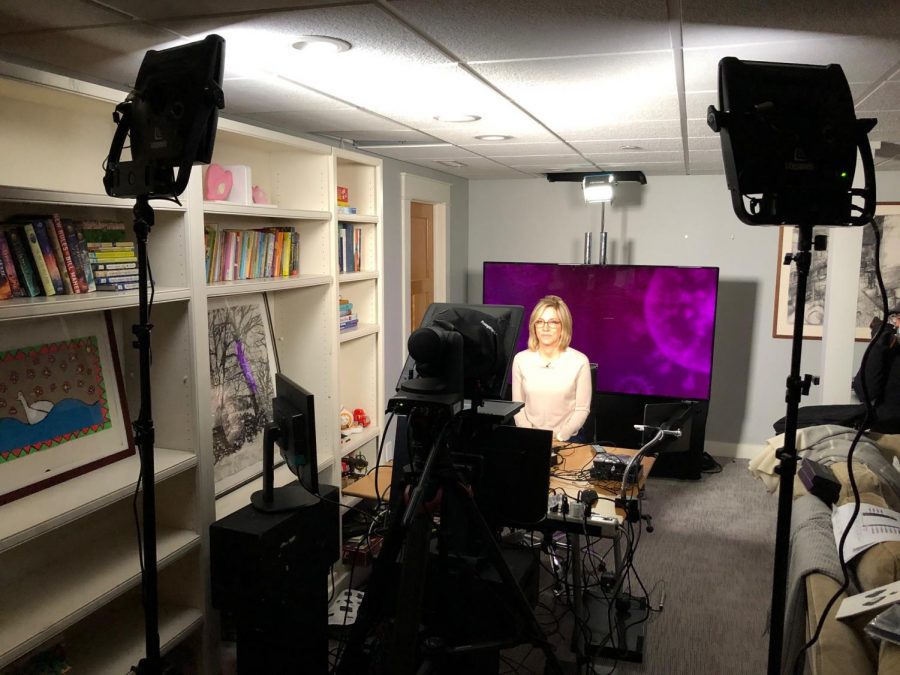National News from Home: How the Coronavirus Has Changed Broadcast Journalism
May 28, 2020
In the past couple of months, it’s been hard to miss the dramatic difference in television news. Reporters wear baseball caps and t-shirts, a lighter coat of makeup, and have messy hair. Their studios have transformed, too; you may now see a game room in the background, or random bookshelves. It seems the Coronavirus has changed the look of the news, but has it also changed the way the journalists report?
I have a front-row seat to the changing appearance of news. I walk down to my basement and mountains of equipment greet me. Television monitors, cameras, lights, microphones, wires, cables, and screens meet teacups and water glasses. Our old, rusty Star Wars Lego set sits next to glossy monitors. A nest of wires clump together under our old art desk. This studio is set up for my mom, Alisyn Camerota, who is a morning anchor on CNN. When being in a studio with cameramen and guests became too risky, home studios like my mother’s were set up to keep journalists safe. I sat down with my mom to gain a greater understanding of the challenges of journalism right now.
How is working from your home studio different from being in the real studio? What is it like broadcasting from home?
It’s fun to be able to wear sweat pants and bedroom slippers while doing my national show, but there are downsides. I am always afraid our dog will come in and interrupt the shot or that Dad will come through in his workout clothes. And there are some technical glitches; sometimes there is a long delay where I don’t hear the guests until a couple of seconds after they have spoken.
What do you do if the WiFi goes out?
We have all sorts of backup systems, as well as backup to the backup systems. But even with that, there have been a couple of occasions where the audio or video has dropped out for a second, and I could hear my producers freaking out in my ear. That’s why the bosses still prefer when I go into our New York CNN studio during the week.
How are you managing to report when you can’t be in the same room as anyone else?
It is definitely challenging. We are doing all sorts of interviews now using Skype or Zoom. It’s very weird to be in a studio all by yourself. I have never had this experience before where for my whole show I am alone. I don’t have a cameraman, I don’t have my producer, coworkers, or anybody with me. That is extremely unusual, but we have the technology to do it. They are using remote-controlled cameras in the studio and my producer is still in my ear so I can communicate with him. Technology has been amazing, but it’s weird to do a whole show where I don’t even see my co-anchor. He’s in an entirely different studio. It’s not ideal.
How do you report on something so few people know about?
We find the best experts we can in the country, meaning doctors, nurses, and scientists, and I just ask the questions I think everybody at home wants to know. Questions like, do you have enough equipment? How are you doing with the influx of patients? When will there be a vaccine? What treatments are working? We all recognize that everyone is learning as we go and might not have the answers. It’s okay right now if people just say “I don’t have the answer to that.” The audience is very accepting that you don’t know everything right now.
What’s it like reporting about thousands of deaths every day?
Well, it is unsettling and it is nerve-racking, but I also think it is very important. I feel that my job right now is extremely important to get the information out to people every morning and to let them know what is really happening in the world. Because so many people have to stay indoors right now, it’s hard to get a handle on what’s really happening and how bad it is out in the world, so I know that people are looking to New Day and to CNN for information. I feel the responsibility of reporting on that. It is very upsetting to look at the numbers every day and realize how many Americans are dying from this.
How do you avoid getting your emotions in the way?
Well, sometimes I can’t avoid it. There are some stories that are so sad and upsetting that I have gotten emotional on television. Normally I try to avoid that because I don’t want my emotions to get in the way of the story, and I want the story to speak for itself, but sometimes it is so sad. We just reported on a young girl, I think she was ten or thirteen and she died. I was kind of getting choked up. I think I am allowed to get choked up right now. That’s a very human emotion. When I heard all the comments from my viewers, they felt like that reflected their own feeling, and they totally understood that news anchors sometimes get teary.
Do you find any time to talk about positive stories?
Yes. Every day we make room in the show to talk about positive stories. We talk about heroes, front line workers, and people who are going above and beyond, giving their time and money to help others. We always take time to tell those stories because it’s so important during a crisis like this.
After the interview, I came to the conclusion that even though everything is a little bit messy right now, we are all in this together. Now, when I walk down to my basement, I acknowledge the clutter and feel pride for my mother’s work, which provides clarity to the American people. Our country is a bit disrupted right now and it’s hard to see through all the chaos and make sense of this new normal. However, not a day has gone by that the American people haven’t gotten the true facts and updates from the news. CNN and other news networks across the country educate the American people and bring important stories to the forefront. In these out-of-place times, news unites us and is with us every step of the way.





Cessa • May 28, 2020 at 8:20 pm
Terrific article, Ale! I love it!